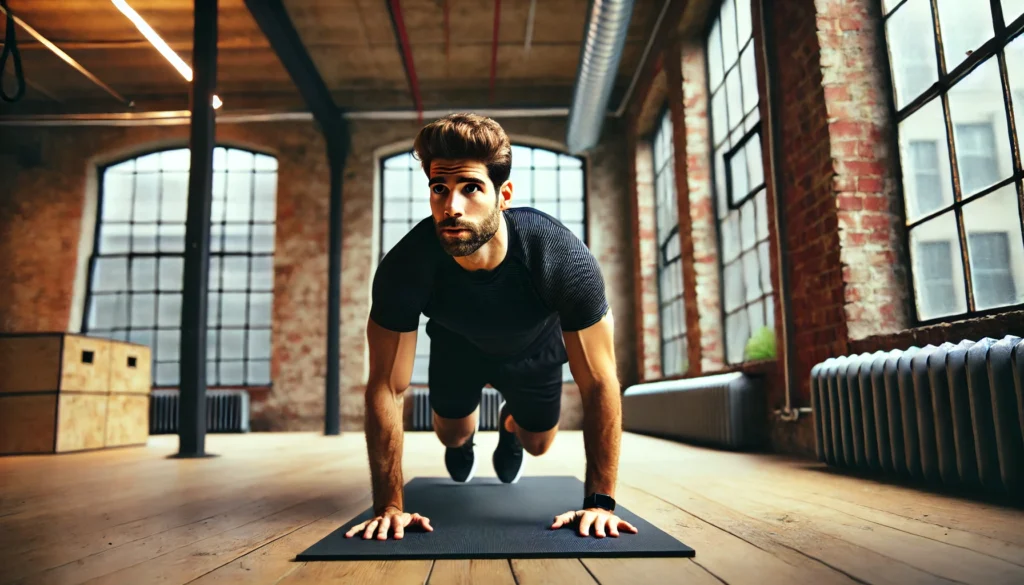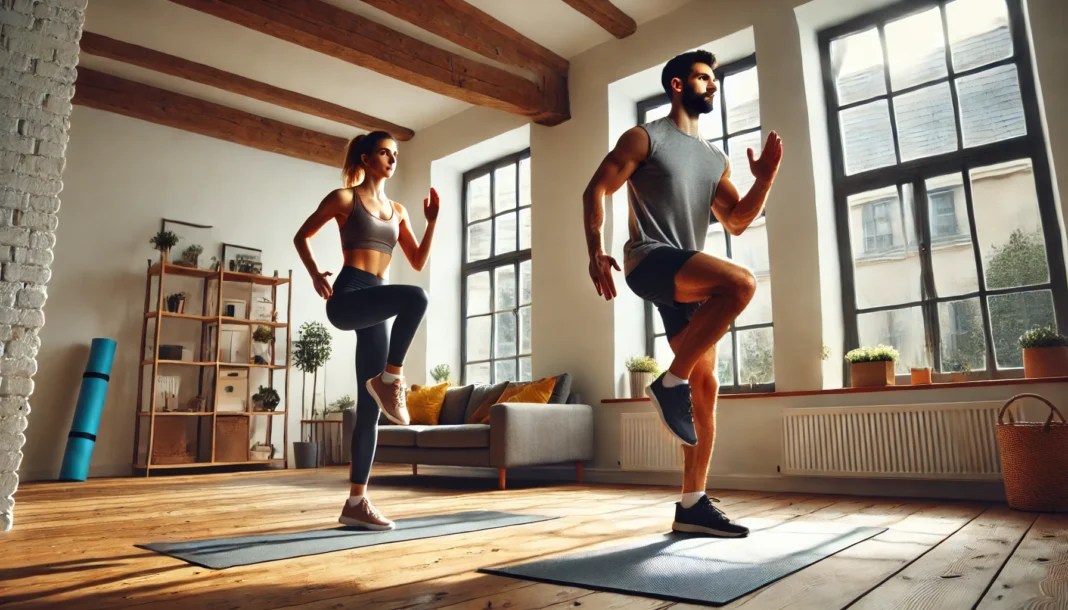Unlock the Power of a 20-Minute Cardio Workout
Endurance training is one of the most effective ways to improve cardiovascular health, increase stamina, and enhance overall physical performance. However, many people believe that they need an expensive gym membership or specialized equipment to achieve a high-quality workout. The good news is that a standing cardio workout offers an efficient and accessible alternative, allowing you to maximize your endurance without the need for machines or weights. Whether you’re an athlete looking to improve your stamina or someone trying to integrate more movement into your daily routine, this 20-minute cardio workout will help you build endurance, boost metabolism, and improve cardiovascular function—all without ever needing to hit the gym.
You may also like: The Ultimate Bodyweight Workout Routine for Full-Body Strength and Performance
Why Choose a Standing Cardio Workout?
Traditional cardio workouts often incorporate exercises that require a treadmill, stationary bike, or elliptical machine. While these tools can be effective, they are not necessary for a high-intensity cardiovascular session. A standing cardio workout can deliver comparable, if not superior, results by engaging multiple muscle groups while promoting functional fitness. These exercises are designed to strengthen your heart, lungs, and muscles while improving coordination and flexibility.
One of the greatest benefits of a standing cardio workout is its accessibility. You can perform these movements anywhere—in your living room, backyard, or even in a hotel room while traveling. This eliminates common barriers to exercise, such as lack of time or access to gym facilities. Additionally, standing cardio exercises place less strain on the joints compared to high-impact activities like running or jumping on hard surfaces. This makes them an excellent option for individuals recovering from injuries or those with joint sensitivity.
The Science Behind a 20-Minute Cardio Workout
Many studies highlight the effectiveness of short, high-intensity workouts in improving endurance and cardiovascular health. A 20-minute cardio workout, when performed with proper intensity, can increase oxygen consumption, strengthen the heart, and promote efficient blood circulation. High-intensity interval training (HIIT) principles can be applied to standing cardio exercises to maximize calorie burn and improve cardiovascular efficiency in a fraction of the time compared to longer, moderate-intensity workouts.
A well-structured standing cardio workout focuses on engaging large muscle groups while maintaining a steady heart rate. Exercises such as high knees, jumping jacks, and squat-to-knee lifts enhance cardiovascular endurance, improve muscle coordination, and stimulate fat-burning mechanisms. The key to maximizing the effectiveness of a 20-minute cardio workout lies in maintaining consistent intensity and minimizing rest periods between exercises.

The Ultimate Standing Cardio Workout Routine
This workout consists of a series of standing cardio exercises designed to keep your heart rate elevated while engaging various muscle groups. Perform each exercise for 45 seconds, followed by a 15-second rest. Repeat the circuit four times for a complete 20-minute session.
1. High Knees
This classic cardio move targets the lower body while keeping your heart rate elevated. Stand tall and jog in place, bringing your knees up to hip level. Engage your core and pump your arms for momentum. Maintain a quick pace to maximize endurance benefits.
2. Jumping Jacks
Jumping jacks are a full-body exercise that increases cardiovascular endurance. Start with your feet together and hands by your sides. Jump up while spreading your legs apart and raising your arms overhead. Return to the starting position and repeat at a steady pace.
3. Squat-to-Knee Lift
This move enhances lower body strength while incorporating a cardio element. Start in a squat position with feet shoulder-width apart. As you rise, lift your right knee toward your chest. Return to a squat and then lift your left knee. Continue alternating sides.
4. Standing Side Kicks
Engage your lower body and core with this dynamic movement. Stand with feet hip-width apart, then kick your right leg out to the side while keeping your core engaged. Return to the center and switch legs. Maintain control to avoid unnecessary strain on your joints.
5. Arm Circles with Marching
This exercise enhances shoulder mobility while keeping your lower body active. Stand tall and extend your arms out to the sides. Begin making small circular motions with your arms while marching in place. Gradually increase the size of the circles to maximize muscle engagement.
Repeat these exercises in a continuous circuit for 20 minutes, adjusting the intensity based on your fitness level. Beginners can perform slower, controlled movements, while advanced individuals can increase speed and effort for a higher-intensity workout.
Maximizing the Benefits of Standing Cardio Exercises
To get the most out of your standing cardio workout, it’s essential to maintain proper form and intensity. Keeping movements controlled and engaging the core throughout each exercise ensures maximum efficiency. Breathing techniques also play a crucial role in sustaining endurance; focusing on deep, controlled breaths helps maintain oxygen flow and prevents early fatigue.
Hydration and nutrition contribute significantly to workout performance. Drinking sufficient water before and after your session ensures proper hydration, which is vital for maintaining energy levels. Consuming a balanced meal rich in carbohydrates, protein, and healthy fats before a workout can provide the necessary fuel for sustained endurance.
How Standing Cardio Exercises Improve Overall Health
Incorporating standing cardio exercises into your routine yields numerous health benefits beyond just endurance enhancement. Regular participation in standing cardio workouts can help regulate blood pressure, reduce the risk of heart disease, and promote healthy cholesterol levels. Additionally, these exercises support weight management by boosting metabolism and increasing calorie burn.
Beyond physical benefits, engaging in a 20-minute cardio workout can positively impact mental health. Cardio exercise stimulates the release of endorphins, which help reduce stress, anxiety, and depression. The rhythmic nature of standing cardio movements can also promote mindfulness, improving focus and overall well-being.

Frequently Asked Questions (FAQ) on Standing Cardio Workouts
1. What makes a standing cardio workout as effective as traditional cardio routines?
A standing cardio workout offers an exceptional way to elevate your heart rate, burn calories, and improve endurance without the need for specialized equipment or a large exercise space. Unlike seated exercises or machine-based workouts, standing cardio exercises engage more muscle groups, leading to improved functional fitness. This form of cardio also enhances stability and coordination by incorporating full-body movements that require balance and control. Additionally, standing cardio workouts can be easily adapted to various fitness levels, allowing both beginners and advanced athletes to benefit from their versatility. With proper intensity and progression, a standing cardio workout can deliver comparable cardiovascular and metabolic benefits to treadmill running or cycling.
2. Can a 20-minute cardio workout genuinely improve endurance and stamina?
A well-structured 20-minute cardio workout can significantly boost endurance when performed at an appropriate intensity. Short-duration, high-effort workouts trigger adaptations in cardiovascular efficiency, oxygen uptake, and muscle endurance, leading to improved performance over time. Standing cardio exercises such as high knees, jumping jacks, and squat-to-knee lifts target key muscle groups while maintaining an elevated heart rate, enhancing stamina efficiently. The key lies in minimizing rest periods and maximizing movement variety to challenge different aspects of endurance. Consistency is also crucial; performing a 20-minute cardio workout regularly will yield noticeable improvements in overall stamina and aerobic capacity.
3. How can standing cardio exercises be modified for beginners or individuals with joint issues?
Standing cardio exercises can be easily modified to accommodate various fitness levels, making them accessible to beginners and those with joint sensitivities. Low-impact alternatives, such as marching in place instead of high knees or performing step-out jacks instead of jumping jacks, reduce joint stress while still providing cardiovascular benefits. Engaging the core and maintaining controlled movements also minimizes strain on the knees and lower back. Additionally, incorporating short rest intervals allows individuals to gradually build endurance without overexertion. Over time, as strength and mobility improve, modifications can be adjusted to include more dynamic movements.
4. How does a standing cardio workout contribute to weight loss?
A standing cardio workout is an excellent way to promote weight loss by increasing caloric expenditure and boosting metabolism. Since standing cardio exercises engage multiple muscle groups simultaneously, they enhance energy expenditure, leading to greater fat burn over time. The intensity and duration of the workout also play a role; a 20-minute cardio workout performed at high intensity can create a significant calorie deficit. Additionally, consistent participation in standing cardio workouts encourages muscle tone development, which further enhances resting metabolic rate. Combined with a balanced diet, this approach supports sustainable weight loss while preserving lean muscle mass.
5. What are some effective ways to increase the intensity of a standing cardio workout?
To maximize the benefits of a standing cardio workout, intensity can be increased in several ways. Adding speed to movements, such as performing high knees at a faster pace, elevates the heart rate more effectively. Incorporating explosive movements like squat jumps or burpees introduces an element of power and strength, further challenging the cardiovascular system. Reducing rest periods between exercises and increasing total workout duration also enhance intensity levels. Engaging in progressive overload by increasing the number of repetitions or incorporating resistance bands for added resistance ensures continuous improvement. By gradually pushing past comfort zones, individuals can experience greater endurance and calorie burn.
6. How does a standing cardio workout benefit mental health?
Engaging in standing cardio workouts provides a substantial mental health boost by triggering the release of endorphins, which help reduce stress and improve mood. The rhythmic, full-body nature of standing cardio exercises promotes mindfulness, allowing individuals to focus on movement and breathing, thereby reducing anxiety. Additionally, regular physical activity has been linked to enhanced cognitive function, memory retention, and mental clarity. The accessibility of standing cardio workouts eliminates common barriers to exercise, promoting consistent participation that reinforces positive mental health habits. Over time, the psychological benefits contribute to overall well-being, motivation, and resilience.
7. Can standing cardio exercises improve posture and balance?
Yes, standing cardio exercises are highly effective for improving posture and balance. Many standing movements require core engagement, which strengthens the abdominal and lower back muscles, leading to better spinal alignment. Exercises such as standing side kicks and arm circles encourage coordination and proprioception, enhancing overall body awareness. Over time, improved balance reduces the risk of falls and injuries, making standing cardio workouts particularly beneficial for older adults. Additionally, maintaining an upright posture during exercises helps counteract the negative effects of prolonged sitting and sedentary behavior. By integrating standing cardio into a routine, individuals can develop a stronger, more stable foundation.
8. Are there specific breathing techniques that can enhance a standing cardio workout?
Proper breathing techniques are essential for optimizing the effectiveness of a standing cardio workout. Deep diaphragmatic breathing ensures adequate oxygen supply to muscles, reducing fatigue and improving endurance. A common method is rhythmic breathing, where individuals inhale deeply through the nose for a few counts and exhale through the mouth in sync with movement patterns. Controlled breathing also aids in maintaining a steady pace and preventing side stitches or cramping. By focusing on breath control, individuals can sustain high-intensity standing cardio exercises for longer durations with improved efficiency. Mastering breathing techniques also contributes to post-exercise recovery and heart rate regulation.
9. How can standing cardio workouts complement strength training routines?
Standing cardio workouts serve as an excellent complement to strength training by enhancing cardiovascular endurance while promoting active recovery. Performing a 20-minute cardio workout on rest days helps maintain heart health without overloading the muscles, allowing for recovery from intense weightlifting sessions. Additionally, integrating standing cardio exercises between strength sets can keep the heart rate elevated, creating a hybrid workout that combines endurance and resistance training. This approach is especially beneficial for individuals looking to maximize workout efficiency while improving overall fitness. Over time, combining both workout styles leads to balanced physical development and enhanced athletic performance.
10. What is the best time of day to perform a standing cardio workout?
The best time to perform a standing cardio workout depends on individual preferences, energy levels, and lifestyle factors. Morning workouts can kickstart metabolism, boost energy levels, and establish a productive tone for the day. Afternoon or evening workouts, however, may benefit individuals who prefer exercising after work or school, allowing them to release built-up stress. Factors such as meal timing, sleep quality, and daily schedule play a role in determining the ideal workout time. Ultimately, consistency is more important than timing, and selecting a period that aligns with personal energy peaks ensures long-term adherence to a fitness routine.

Conclusion: Take the First Step Towards Improved Endurance
A standing cardio workout provides a highly effective way to enhance endurance, improve cardiovascular health, and strengthen muscles without the need for expensive equipment. By incorporating this 20-minute cardio workout into your routine, you can experience the benefits of increased stamina, better circulation, and overall improved fitness. Whether you’re a beginner or a seasoned athlete, the flexibility and accessibility of standing cardio exercises make them an ideal addition to any fitness regimen. Stay consistent, push your limits, and embrace the challenge of achieving peak endurance through effective, equipment-free workouts.
endurance training, high-intensity workout, heart health, fitness motivation, aerobic exercise, bodyweight training, metabolism boost, cardiovascular endurance, workout routine, functional fitness, HIIT cardio, weight loss exercise, fat-burning workout, stamina building, home workout, active lifestyle, full-body workout, strength training, heart rate training, wellness routine.
Further Reading:
You don’t need machines— this no-jump cardio workout burns calories and builds strength all over
This No-Equipment Cardio Workout Takes Just 20 Minutes
Important Note: The content provided by HealthXWire is for informational purposes only and should not be construed as medical advice, diagnosis, or treatment. While we strive for accuracy, the information presented on this site may not reflect the most current research or medical guidelines. Always seek the advice of your physician or other qualified health provider with any questions you may have regarding a medical condition. HealthXWire does not endorse, recommend, or guarantee the efficacy of any products, services, or treatments mentioned on this site. Users should not disregard professional medical advice or delay seeking it because of something they have read on HealthXWire. HealthXWire is not liable for any damages, loss, or injury arising from reliance on the information provided herein.



